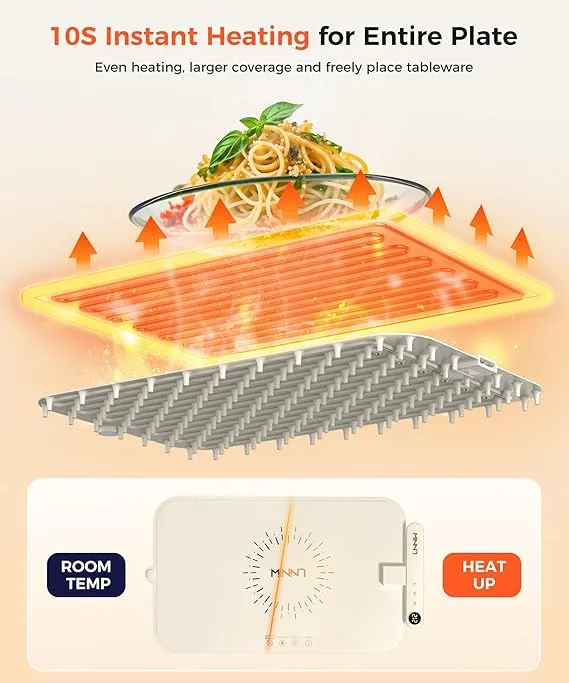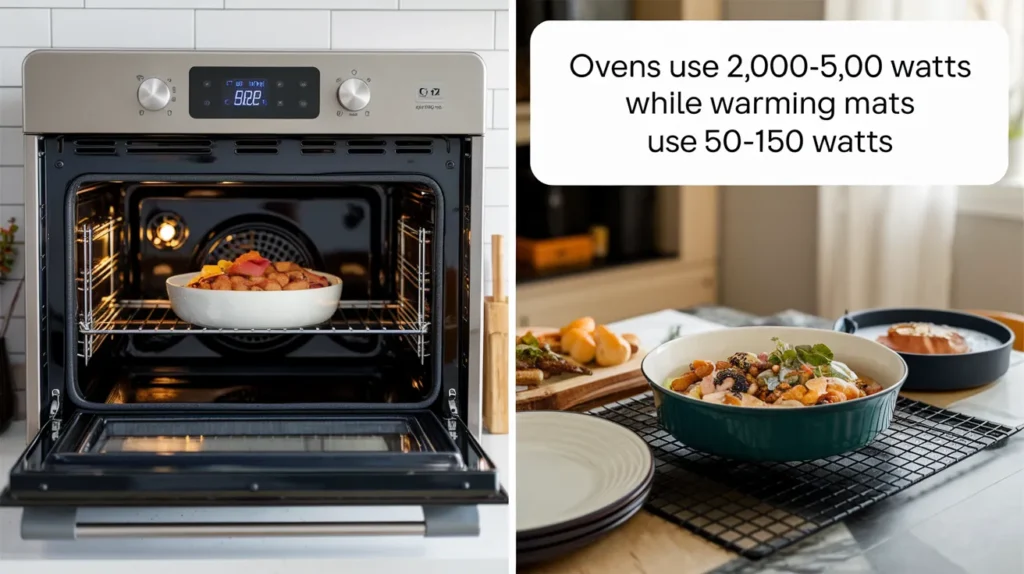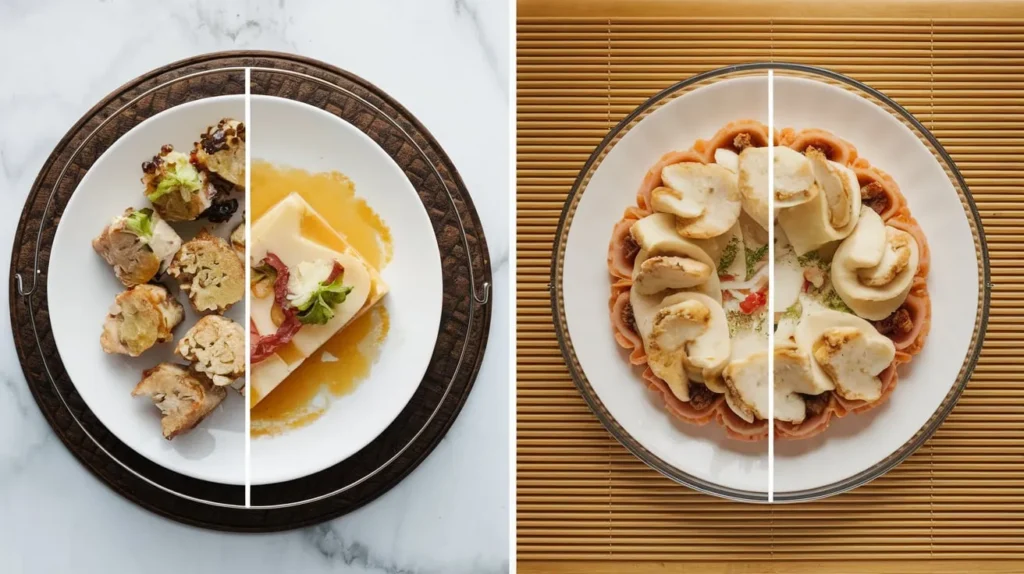Have you ever wondered, “Do electric food warming mats use a lot of electricity?” The answer is no! These mats are designed to consume minimal power. They are not comparable to large kitchen appliances. They help save energy and money, allowing you to keep food warm without increasing your electric bill.
Key Takeaways
- Electric food warming mats use 50-150 watts of power. They are more energy-saving than ovens or microwaves.
- Picking a mat that fits your dishes saves energy. Smaller mats heat up quicker and use less power.
- Turn off the mat when you don’t need it. This easy step cuts down on wasted electricity.
“A good food warmer keeps your meal hot without burning a hole in your pocket.” — Chef Lisa Reynolds
How Electric Food Warming Mats Work
Basic functionality of food warming mats
Let’s make it simple. Electric food warming mats are easy to understand. They have a heating wire under the mat. This wire spreads heat evenly, keeping food warm without cold spots. Most mats have a control panel on the side. You can change the temperature or set a timer easily. Some mats even turn off automatically if you forget. Many also have cool edges, so you don’t burn your hands while using them.
Here’s an example: the TempMaster™ mat is made of strong silicone material. It handles heat well and spreads it evenly. Whether you’re warming plates or keeping soup hot, it works great and saves energy.
How they generate and maintain heat

These mats heat up fast and keep the temperature steady. Some models start warming in just 8-10 seconds. That’s quick! They use smart heating tech, like NTC (Negative Temperature Coefficient), to spread heat evenly.
Here’s a quick list of features:
| Feature | Description |
|---|---|
| Rapid Heating | Heats up in 10 seconds for fast use. |
| Adjustable Temperature Levels | Lets you pick different heat settings (e.g., 140°F, 176°F, 212°F). |
| Automatic Shutoff | Turns off by itself to save power and keep you safe. |
These mats are super useful. You can warm food, defrost frozen items, or dry small tools. Their silicone material spreads heat well, keeping your food warm and tasty.
Why their energy consumption is low
You might ask, “Do these mats use a lot of electricity?” The answer is still no! They are made to save energy. Most mats use only 50-150 watts, depending on their size. That’s much less than an oven or microwave. Features like adjustable heat and auto-shutoff also help save power.
Think about it. Instead of reheating food in a microwave, you can keep it warm on a mat for hours. It uses very little electricity. It’s good for your wallet and the planet!
“Efficiency in the kitchen isn’t just about time—it’s about smart energy use.” — Energy Expert Mark Simmons
Do Electric Food Warming Mats Use a Lot of Electricity? Energy Consumption Analysis
Typical wattage of electric food warming mats
When I first looked into electric food warming mats, I was surprised by how little power they use. Most mats operate between 50 and 150 watts. To put that into perspective, a standard oven uses around 2,000 to 5,000 watts, and even a microwave can use up to 1,200 watts. That’s a huge difference!
These mats are designed to be energy-efficient, so they only use the power they need to keep your food warm. If you’re like me and want to save on electricity, these mats are a great option.
Example of electricity costs for daily use
Let’s break it down. Say your mat uses 100 watts and you keep it on for 5 hours a day. That’s 0.5 kilowatt-hours (kWh). If electricity costs 15 cents per kWh, you’d spend just 7.5 cents a day. Even if you used it every day for a month, the total cost would be around $2.25. That’s less than the price of a cup of coffee! So, do electric food warming mats use a lot of electricity? Not at all. They’re incredibly affordable to run.
Factors that influence energy consumption
Several factors can affect how much electricity your mat uses. The size of the mat matters—a larger mat will use more power than a smaller one. The temperature setting also plays a role. Higher settings consume more energy, while lower ones save power.
Some mats come with insulation or covers that help retain heat, reducing the need for extra energy. I always recommend turning off the mat when you’re not using it. It’s a simple way to save even more electricity.
Comparison with Other Appliances
Energy usage of warming mats vs. ovens

I’ve always been amazed by how much energy ovens use. They’re great for baking and roasting, but they’re not the best choice for keeping food warm. Ovens typically use between 2,000 and 5,000 watts. That’s a lot of electricity! In comparison, electric food warming mats only use 50 to 150 watts. It’s like comparing a race car to a bicycle. If you’re just trying to keep food warm, a warming mat is the smarter, more energy-efficient option.
Warming mats vs. microwaves for reheating food

Microwaves are quick, but they’re not always the best for reheating food evenly. Plus, they use up to 1,200 watts of power. I’ve found that warming mats are a better choice when you want to keep food warm for longer periods. They use much less electricity and don’t dry out your food like a microwave can. If you’re hosting a party or just want to enjoy a warm meal later, a warming mat is a great alternative.
How warming mats compare to slow cookers or hot plates
Slow cookers and hot plates are handy, but they’re not as energy-efficient as warming mats. Slow cookers use around 200 watts, while hot plates can use up to 1,500 watts. Warming mats, on the other hand, are designed to use minimal power. They’re perfect for keeping food warm without overcooking it. I’ve noticed that they’re also safer to use, especially if you have kids around.
Tips for Energy-Efficient Use
Pick the right mat size for your dishes
Choosing the correct mat size helps save energy. Always match the mat to the size of your dish. Smaller mats use less power and heat up quicker. Why use a big mat if a small one works? Smaller mats also save time by warming faster. Many companies now offer mats in different sizes. This change supports sustainability, with some mats made from recycled or eco-friendly materials.
Why the right size mat matters:
- Saves energy by using less power.
- Heats up quickly, saving time.
- Supports eco-friendly and sustainable choices.
Turn off the mat when not needed
It’s simple but important—turn off your mat when done. I always unplug mine after use. This small habit saves a lot of energy. Experts recommend turning off appliances like warming mats when not in use. Here’s why this is important:
| Reason | Benefit |
|---|---|
| Turn off or unplug unused mats. | Stops wasting electricity. |
| Use appliances that fully turn off. | Avoids energy loss from idle devices. |
| Choose mats with quick warm-up times. | Reduces energy use and saves power. |
Use mats with adjustable heat settings
Mats with adjustable heat are super helpful. You can pick the exact temperature you need. Lower heat settings save energy and prevent overcooking. Many mats also turn off automatically, saving even more power. Some mats use as little as 0.25 degrees per hour. That’s very efficient! Here’s why these features are great:
| Feature | Benefit |
|---|---|
| Adjustable Heat Control | Lets you choose the best temperature for your food. |
| Low Energy Use | Uses very little power, even for long periods. |
| Auto Shut-off | Turns off by itself to avoid wasting energy. |
Choose energy-saving models
When buying a mat, look for energy-efficient options. These mats use less power but still work well. Many brands now highlight energy-saving features. The market for warming mats is growing fast, with new eco-friendly designs. Picking an energy-efficient mat saves money and helps the planet.
Tip: Check for energy-saving labels or certifications. Small choices can make a big impact.
Electric food warming mats are super useful and save energy. They don’t use much electricity compared to ovens or microwaves. These mats are also affordable and great for everyday use. Turning them off when not needed helps save even more power. They’re a smart option for anyone wanting to lower energy bills.
“Good food deserves to stay warm, and now it can without waste.” — Home Chef Rachel Wong
Conclusion
Electric food warming mats are a low-energy, cost-effective solution for keeping meals warm. Using only 15–40 watts, they add mere cents to your electricity bill per use. Whether for family dinners or parties, these mats offer convenience without high costs.
FAQ
How long can I leave food on a warming mat?
Most mats can keep food warm for several hours. I recommend checking the manufacturer’s instructions for the safest and most efficient usage time.
Are electric food warming mats safe to use?
Yes, they’re safe! Many mats have features like cool edges and auto shut-off. Just follow the instructions, and you’ll have no issues.
Can I use a warming mat for other purposes?
Absolutely! I’ve used mine to defrost frozen food and even dry small items like utensils. Just make sure it’s safe for the material you’re warming.
Can I leave a food warming mat on all day?
While safe, it’s best to use it only when needed to save energy.
Do warming mats work for all types of dishes?
Yes, but avoid direct contact with extremely hot cookware.
Are they safe for countertops?
Most mats have heat-resistant designs, but check manufacturer guidelines.
How long do electric warming mats last?
With proper care, they can last 3–5 years or more.

